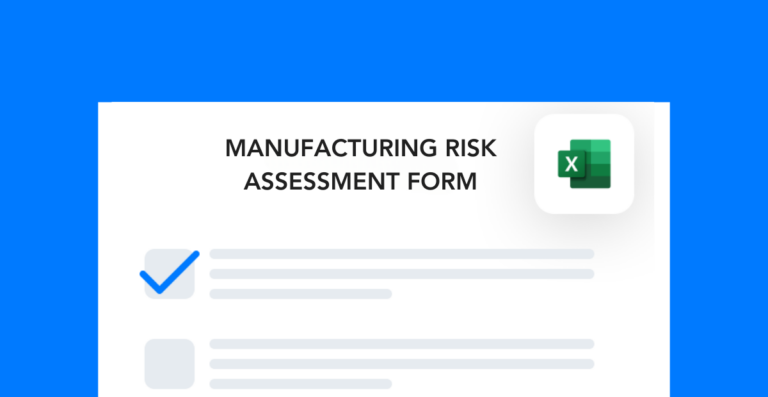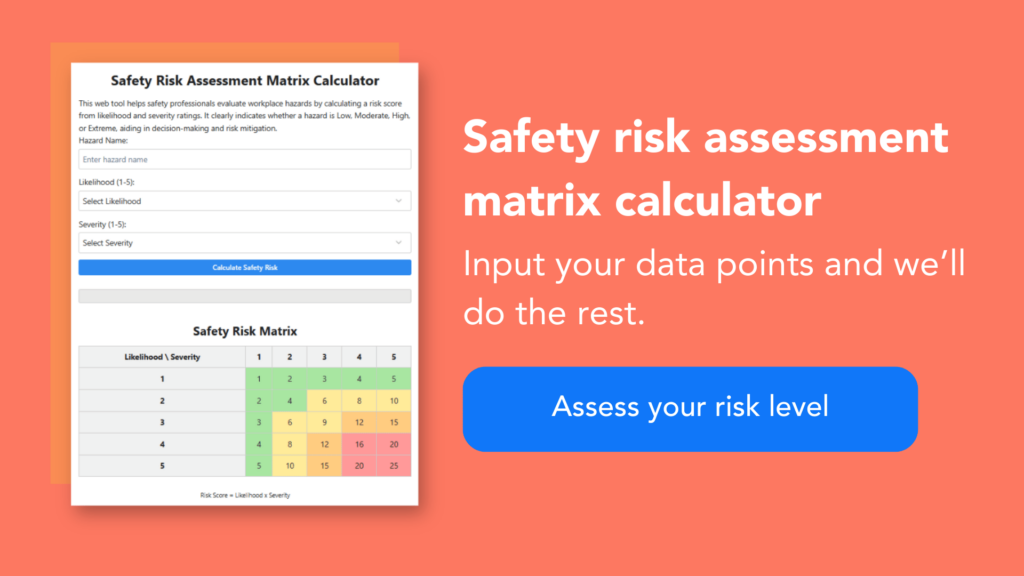There were more than 4,100 preventable injury-related deaths in 2020, a figure which actually decreased during the COVID-19 pandemic. And some of the most vulnerable work environments for these deaths include construction, warehousing, and manufacturing.
You can’t prevent 100% of workplace incidents, but you can complete risk assessments to identify any hazards that might cause them. Performing regular audits is important for proactively preventing incidents that put your workers in danger and jeopardize your business’ reputation. To make this process even easier, consider creating a manufacturing risk assessment template that you can use for every incident.
What is risk assessment?
In the manufacturing industry, you can prevent almost every single near miss or injury. Oftentimes, leadership only recognizes a major hazard after an incident occurs. A risk assessment is an audit that focuses on identifying hazards before they cause an incident.
The most common reason why manufacturing companies perform risk assessments is to prevent workplace injuries and deaths. But you can also use these audits to avoid operational failures. This includes a variety of variables like:
- Equipment dangers and/or potential failures
- Property damage
- Health hazards (EX. mold, asbestos, etc.)
- Electrical component dangers
- Fall hazards
- Sharp fixtures
Have you ever seen an incident that could have been easily prevented if the area had been assessed beforehand? This is where risk assessments come in handy. You can use risk assessments in all manufacturing settings. They will provide you with a structured approach for proactively finding and controlling hazards.
To summarize, a risk assessment is a process of figuring out potential workplace safety and health hazards through inspection, incident investigation, and implementation of controls.
Benefits of manufacturing risk assessments
Risk assessments are beneficial for all types of manufacturing safety programs. One of the most important and well-known benefits of risk assessments is that they prevent incidents. However, there are other pros in performing risk assessments.
They help to familiarize safety professionals with the manufacturing environment and its processes. This may shorten a site’s response time when incidents occur. Plus, it makes safety teams stronger, given that everyone has the same knowledge and knows what to look for.
Another benefit of risk audits is that they get workers involved in promoting safety. When you include floor associates in assessments, you make them more aware of potential hazards around the facility. This also makes workers more comfortable reporting potential risks.
Furthermore, performing risk assessments can reveal dangers that workers did not notice before. When the workers are involved in the risk assessment process, they become educated on the controls to protect themselves from safety hazards. And they may be more likely to use the controls and take part in a safety program.
After controls are in place, you can reevaluate workplace hazards to estimate whether more controls would be beneficial. Keep in mind that there are many ways of controlling hazards, so don’t feel limited in your approach.
Incorporating risk assessment into EHS programs
You can perform risk assessments on current manufacturing processes to set up a baseline. When you implement new processes, make sure to reassess workplace risks and decide whether you need to change any of your existing controls to accommodate changes.
Here are some possible examples of when you should perform a new risk assessment:
- If there is a new piece of equipment arriving on the floor that workers will have to use
- If workers will be expected to start a new procedure that was not in use before
- If there is a new chemical being brought in for use in an existing process
It is important to note that risk assessment should not be thought of as a “one and done” procedure. Instead, risk assessments evolve and help keep track of past assessments and plan for future controls. An excellent way to do this is to use a risk assessment template or checklist, both of which you can easily create and customize for use in a specific manufacturing facility.
Risk assessment with Frontline ACT
Use our action tracking system, Frontline ACT, to coordinate the follow-up actions from your risk assessment results.
Assessing hazards in your manufacturing facility
Next, think about which types of processes or tasks you need to prioritize in your assessments. For example:
- Does the facility have many stored chemicals that you use often?
- Are workers expected to lift heavy objects?
- Are there machines that need daily or unique maintenance work?
Every facility is different, but you can spot many (if not all) hazards by carefully and methodically auditing an area for risks and potential solutions.
After finding a task that you want to assess, list its associated hazards. Include a system for rating hazards based on how potentially dangerous they are to your workers. Are the hazards dangerous enough to cause severe injury or death? Is it something that would only require basic first aid?
Note that if your facility has a history of incidents related to a particular hazard, you may need to require more training. Once you have assessed the severity of a hazard, decide how often workers encounter it.
For example, if the hazard is a task such as working on a machine with moving parts, how often will workers be expected to use the machine during a shift? If the hazard is exposure to a chemical or loud noise, how often will workers encounter these issues? Rank the hazards on a scale of lowest to highest frequency.
Next, ask workers about both the standard and non-routine tasks they are expected to perform. If a task is performed often, it may help to prioritize a risk assessment for it. However, if a non-routine task is highly hazardous, it may need to be first on the list.
Risk control measures
Now that the hazards have been listed and ranked, it’s time to think about controls. Implement controls as needed, starting with the most frequent or severe hazards. Once the controls are put in place, revisit the area to check if the controls are adequate or if more stringent measures are needed.
If you want an easier way to record risk assessments and track controls, consider implementing a risk management software solution. This makes it easier to decide whether your manufacturing risk assessments are effective at preventing incidents in your facility.
Other posts you might like…
No posts


